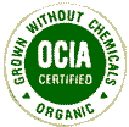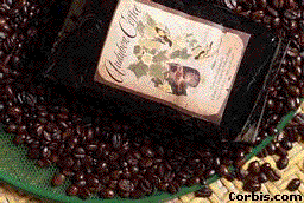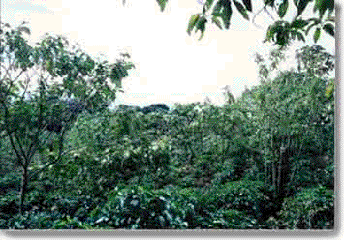| Shade Grown Coffee |
| Currently coffee is grown in two methods: by using the tradition shade grown technique or the newer more efficient Sun grown technique. |




Because sun-grown coffee needs these chemicals it is not considered environmentally friendly. Also as the name might suggest it is grown in the sun. This is not how coffee naturally grows and it is hard on the plants. Natural
coffee shrubs can not survive in direct sunlight so special hybrids are needed. These hybrids have a shorter life span and produce coffee with a bitter taste.
Naturally and traditionally coffee has been grown under the shelter of shade trees. These trees break the light and ease the severity of rainstorms. They also help to minimize soil erosion, use of pesticides, and amount of labor needed. The trees mimic the natural rain forest and present homes for most of the migratory bird of North America.
Pests that eat away the sun grown coffee shrubs are food for the birds and are not a problem to the farmers. The soil when containing shade trees has a fixation of Nitrogen, which makes coffee more sustainable.
Growing coffee in the sun costs a lot, due to the fact that the chemical fertilizers and pesticides are expensive. It also costs a lot to implement these chemicals (seeing as you need a labor force to do so). Clear-cutting the land and replacing coffee bushes every 12-15 years is not cheap either. However growers feel it is worth the costs because the profit is so great. The demand is set so now that the more they can produce the more money they make. That demand is very good for business and the increased yield that comes with sun-grown coffee is good news for them. Sun-grown coffee plantations hold up to 1600 plants per hectacre of land compared to the 550 on shade-grown plantations (per hectacre).


Even though there is lots of money to be made by using the Sun-grown technique there are some reasons to return to the tradition method. First off it costs less, because you don't have to pay for clear cutting, chemicals, and as much labor maintenance as is needed in sun-grown coffee production. There is also the demand for organic coffee which consumers are willing to pay a lot more for. That means growers can get a lot more money per pound they produce. Consumers also care that it is better for the environment and wildlife. The environmental impact makes for a very powerful marketing tool, because environmentally minded people are much more likely to buy something that says "Environmentally Friendly" on it rather then one that does not have that on it.
Growing coffee in a way that it is more sustainable means that the land will be good for a longer period of time. So when I say, "shade-grown coffee is less harsh on the land" you can notice that I mean the land will be worth more, longer. The coffee shrubs that grow in the shade have a life span of up to 30 years meaning the cost of plant replacement is low (you don't have to replace them as often as the hybrid plants).
The retail price of sun grown coffee is very cheap. That is why it is used at so many chain restaurants and sold at so many stores and gas stations around the globe. To find the differences in prices between shade- and sun- 

grown coffees local stores were called. The first task was to get a figure on how much `normal' coffee costs. So I called a grocery store in my area (Shaws: Brunswick Location) and requested the price of "Maxwell House Coffee Original Flavor". They told me that the price per pound on the 16-oz tin was $3.68 and on the 39-oz tin the price per pound was $2.86. So the average
price for this coffee was $3.27 (per pound). Meanwhile the next step was to determine the cost of shade-grown coffee. This would be harder because fewer stores carried it. The first place that was called was a local health food store (Morning Glory, Brunswick Location). They were asked if they carried shade-grown coffee and what was the price per pound if they did. The sales person who talked to me was very nice and told me that they did indeed sell shade grown


coffee, the name of the brand being "New Guinea Blend" which they sold for $11.99 per pound. Because I had forgotten about calling the stores until Sunday most of the shops I called were not open. I did get through to a highly recommended coffee shop (Bohemian Coffee Shop: Brunswick Location) that said they did not have shade grown coffee. They were very rude to me and I wonder whether that is the truth or a way to get me to leave them alone (they were very busy). The next person I got through to was the "Nature store" at Maine Audubon in Freeport. They said they sold shade-grown "Song Bird Coffee" for $9.95 per pound. So I hypothesized that the average cost of shade-grown coffee is around $10.97 and the average price per pound for sun-grown coffee is $3.27 (that is only Maxwell House coffee others may vary).
Shade-grown coffee is so much more expensive is because there is less supplies, there are considered health benefits and it has a richer taste. It is assumed better for your health if you eat and drink things that have not been grown with the use of chemicals. Shade grown coffee is usually organic making it worth more. The taste is richer and mellower then sun-grown coffee because when allowed to grow slowly, coffee develops all kinds of natural sugars and flavors.
Rainstorms effect sun-grown land a lot, because there is no protection given as there naturally is by the shade trees. The rain erodes the soil, seeing as there are no roots to hold it together. It pounds away on the plants mercilessly, causing a lot of toxic run off and soil acidification.

There are no side crops that can be grown on sun-grown plantations while many can on shade plantations. The animals and birds that are having their habitat destroyed lose their homes again to the production of coffee. Is this really how the rain forest should go?
It seems as though any person who has seen this information will pay more attention to the coffee they buy and will at least understand what its effect on the environment is. Who knows maybe some of them would even care enough to pay the extra $7.00 per pound for coffee that will end up helping the environment so much!

| One World | HOME |
| Sea Otters | Humpback Stranding | Bird Quiz | Right Whales | Shade Grown Coffee | Arctic | Basilosaurus | Antarctic Zebra(fiction) |